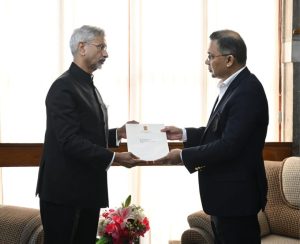India begins matching Chinese infra push to Nepal with Rail upgrade

Photo credit Twitter Sher Bahadur Deuba
By Manish Anand
New Delhi, August 4: India has stepped up its efforts to wean away Nepal on the lines of Sri Lanka from the Chinese arms. On Wednesday, a key infrastructure group of the Centre gave its nod to upgrade a crucial rail line to Birat Nagar that overlooks North-eastern parts of India and Bihar.
The railway project promisers to give a robust connectivity to Nepal’s one of the largest trading hubs, while also connecting the Himalayan nation to Kolkata port, which will allow Kathamndu an access to the Bay of Bengal to open up additional opportunities for trade and commerce.
“Network Planning Group constituted under the institutional framework of PM GatiShakti National Master Plan has examined and recommended three important railway projects — doubling of Gorakhpur Cantonmentt – Valmikinagar rail line, Katihar – Mukuria and Katihar – Kumedpur doubling and Pachora – Jamner Gauge Conversion and Extension upto Bodwad,” said the government in an official statement on Thursday.
All the three projects are extremely important with a view to ensure faster movement of goods in the hinterland which will accelerate the logistics efficiency and bring reduction in logistics costs, added the government.
Katihar–Mukuria and Katihar–Kumedpur are extremely busy sections. Currently, this is single line and it is a Rajdhani train route.
“This is important link to connect the Northeast and also Howrah. Doubling of these sections will significantly help movement of cargo from Kolkata Port to Virat (Birat) Nagar. The cost of this project is Rs 942 Crore,” added the government in the statement.
Jogbani in Bihar is the neighbouring big city of Birat Nagar, which also overlooks Silliguri, the gateway to Sikkim and the other Northeastern states.
This railway line is also strategically considered crucial for the faster movement of the armed forces personnel and the defence goods.
It may be worthwhile to note that China also overlooks this area with key strategic infrastructure projects, which have been built to further its strategy of the incremental gains of the land of neighbouring countries as had been the case in the nearby Doklam areas.
It’s also significant that the decision of the key infra group has come at a time when Prime Minister Narendra Modi had visited Lumbini in Nepal, while his Nepalese counterpart Sher Bahadur Deuba also came to New Delhi to a warm welcome in April this year.
The high level official exchanges have also been followed at the political levels, as the ruling Bharatiya Janata Party hosted former Nepal Prime Minister Pushpa Kamal Dahal ‘Prachanda’ recently.
Indeed, the strategic affairs observers have noted India’s determined bid to push out China from Nepal by reaching out to Kathmandu to address their key concerns.
The Prime Ministers of the two countries have also taken off the tension by prevailing upon Kathmandu to not politicize the border issues.
It may also be recalled that the Nepalese economy bore the brunt of the ‘Zero Covid Policy’ of China, which blocked the entry of the Nepalese trucks for several months.
Also, Nepal has of late begun getting wary of the Belt and Road Initiative of China and its pitfalls as seen in Sri Lanka and several other countries in Asia, Africa and Latin America.




